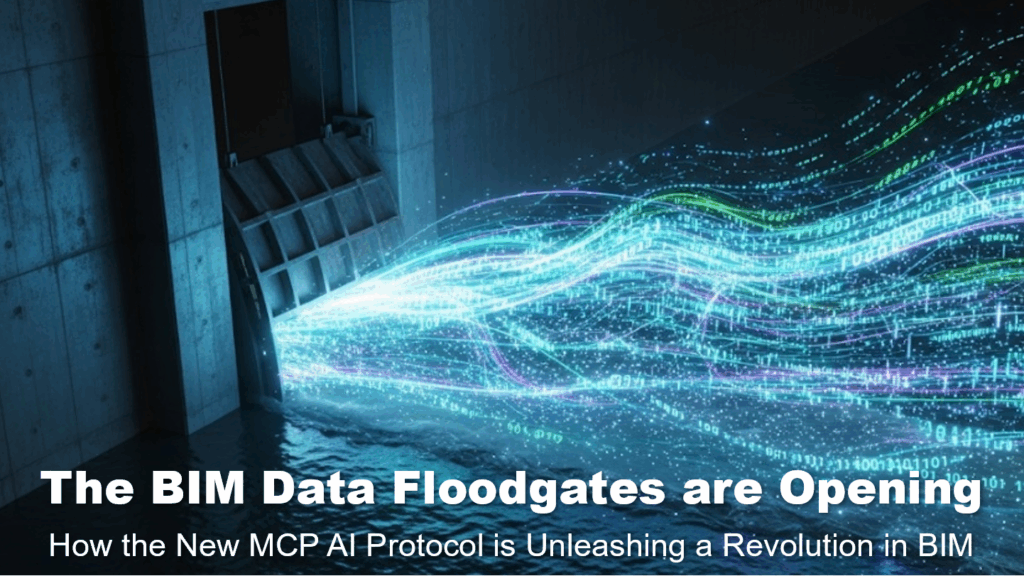How the New MCP AI Protocol is Unleashing a Revolution in BIM
For years, the promise of interacting with complex Building Information Models (BIM) using simple, natural language through AI (Artificial Intelligence Large Language Models) has been a holy grail for the AEC industry. Now, a quiet but powerful shift is turning that vision into a tangible reality. A new open standard, the Model Context Protocol (MCP), is serving as the universal translator, and recent developments show that the floodgates connecting AI to BIM are finally opening, with innovation now erupting on three distinct fronts: open-source pioneers, major software vendors, and a rapidly growing grassroots movement focused on the popular Autodesk Revit software. The industry is not just on the verge of a new era; it has already entered it.
What is MCP? The Lingua Franca for AI and Tools
At its heart, the Model Context Protocol (MCP) is an open-standard communication framework that allows AI models, like Anthropic’s Claude, to interact with external tools and data sources. Initially promoted by AI labs like Anthropic and Google DeepMind, it provides a simple but robust client-server architecture using JSON (JavaScript Object Notation). This prevents the need for brittle, one-off or custom integrations, instead creating a common language for an AI to request information or delegate tasks. Think of it as a USB-C port for AI—a single, standardized way to connect anything to everything.
The Three Fronts of Innovation
What makes the current moment so significant is that MCP is not being adopted in a vacuum. Instead, a three-front revolution is underway, proving the standard’s viability from the bottom-up, the top-down, and now, from the inside-out.
1. The Open-Source Vanguard: The Proof of Concept
The first wave of innovation came from the vibrant open-source community, largely centered around the OSArch Community. A project named Bonsai-mcp emerged as a key implementation, acting as an MCP server that runs inside the popular open-source 3D tool, Blender.
This server uses the industry-respected IfcOpenShell as its core engine—a powerful, vendor-neutral library for reading and processing IFC files. The result was a complete, working chain demonstrating the possible: a user could type a natural language query to an AI, which then used MCP to command the Bonsai server in Blender to run a query on an IFC model and visualize the result. This grassroots effort proved it could be done.
Powered by a Proven Engine: Much of this open-source innovation is made possible by foundational toolkits like IFC.js. Developed by pioneers at That Open Company, this library solved the core challenge of making complex IFC data accessible in web browsers, and on devices, providing the essential engine upon which many new applications, including AI-driven ones, can now be built to serve multiple users.
2. The Industry Giants Engage: The Validation
In a move that validated the entire ecosystem, AEC software giant Autodesk signalled its own investment in this space. In a detailed post on their APS blog, developers outlined a proof of concept for “talking to your BIM.” Their project uses the exact same open protocol (MCP) and the same AI (Claude) to connect to their proprietary AEC Data Model. This public-facing R&D demonstrated that even the industry’s largest players recognize the strategic advantage of adopting open standards to connect their platforms to the rapidly evolving world of AI. It was no longer a niche experiment.
3. The Revit Revolution: The Mainstream Adoption
Most recently, and perhaps most significantly, the movement has found its primary target: Autodesk Revit users, one of the most popular BIM authoring software tools. A new wave of developers is now bringing MCP directly into the world’s most ubiquitous BIM authoring tool, bypassing official vendor timelines and putting this power directly into the hands of designers.
- Dedicated Tools Emerge: A project named Revit-mcp, complete with its own GitHub repository, has appeared, offering a direct way to connect AI assistants like Claude to a live Revit session.
- Community and Tutorials: Independent creators are already producing step-by-step tutorials, like the “Revit + Claude MCP Set Up for Beginners” video, demonstrating a clear demand and a willingness to share knowledge.
- A Growing Marketplace: We’re even seeing the early signs of a commercial ecosystem with tools like “Direwolf: BIM Data Extraction & AI Integration for Revit“ appearing on marketplaces, designed to facilitate data exchange between Revit and MCP-compatible AI agents.
This is a profound shift that moves the technology from the world of the open-source enthusiast to the desktop of the daily practitioner, signalling a market desire so strong that the community is building the future themselves.
A New Era of Interoperability is Here
The simultaneous emergence of open-source tools, official vendor explorations, and a passionate user community around a single, open protocol marks a pivotal moment. The theoretical promise of AI in AEC design is over. We are now in the implementation phase. The future is not about one tool winning, but about a diverse ecosystem of tools—some open, some commercial, some user-built—that can all communicate through the common language of MCP. The “walled gardens” are being replaced by common ground, and the ability to simply talk to our models is arriving faster than anyone thought possible.



